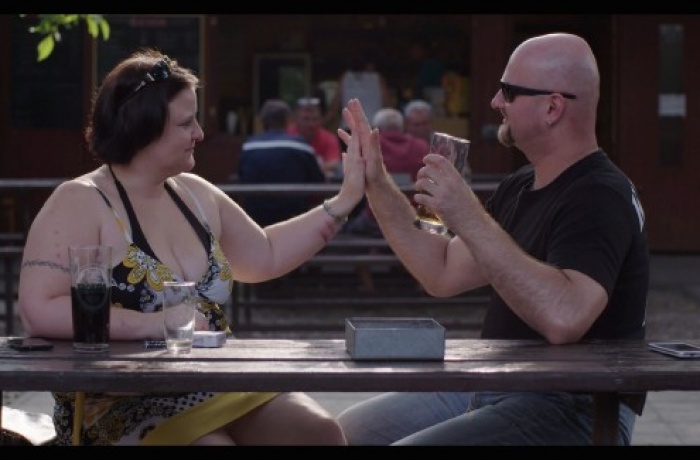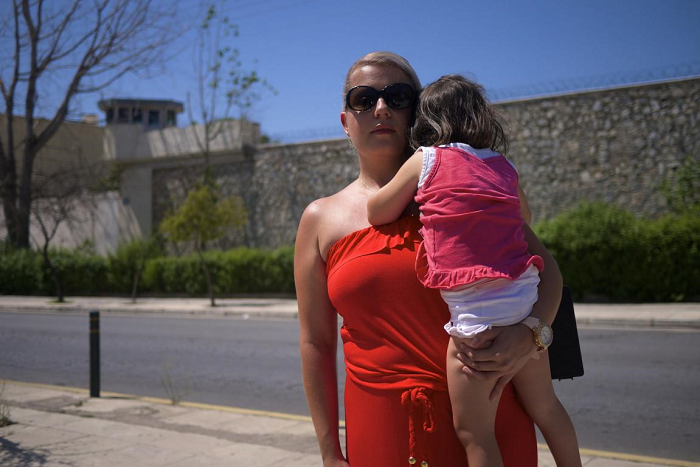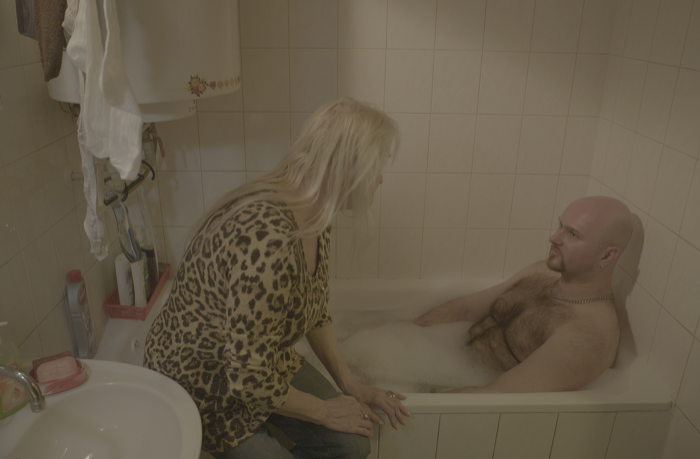
You can expect many things from a programme of documentary films about racial discrimination. For example, some kind of high moral tone, journalistic sharpness or a darkness of material. But probably not peacefulness. However, in fact, what all the three films of the special Neo-Inequality program at this year’s Docudays festival have in common is their peaceful, balanced tone.
The films included in the programme do not throw us into any radical hells of interpersonal hostility, as it might seem at the beginning. Instead, they reveal the key topic from a completely different perspective by showing us ordinary people whom we could meet in our everyday lives. In the formal sense, the authors of these films aim to portray the private human face of all those frightening figures which are lurking behind the terms ‘neo-Nazis’ or ‘colonists.’ Evil monsters show themselves in their ordinary, routine roles. And this is where the most interesting things begin, because as it turns out, the routine can actually allow us to get a glimpse of hells which we couldn’t even have imagined before. Every film in the programme achieves this goal of expanding the limits of our perception, our imagination, in its own individual way.
Golden Dawn Girls, by the Norwegian director Håvard Bustnes, takes us behind the scenes of the family life of Greek neo-Nazis from the highest ranks of the Golden Dawn party. This film came about thanks to a peculiar situation in the party elite. Several party bosses were put in jail to await trial, and the responsibility for the fate of the enterprise was laid on the shoulders of high-ranking women, the daughter of the leader and the mother and the wife of his right-hand man.
The women left behind graciously agreed to show their everyday lives to the camera, although of course they presented themselves as public figures in a favourable light. Actually, this is the origin of the central tension of the film: the attempts of the protagonists to present themselves in a normal light, despite the openly condemnatory view of the director. It is also the source of the central intrigue: how successfully the ‘golden’ girls will be able to preserve their masks. In this process, each of them has her own role and her own camouflage. But, naturally, through the cracks of their ‘show-off privacy,’ certain interesting unplanned moments manage to escape.
The film is rather simple in form. The main goal of the film crew is to make a high-quality recording of whatever they are allowed to record. The director obediently follows the protagonists, allowing them to pick locations and angles at their own discretion. The Golden Dawn girls keep complaining that they are never allowed to express their position properly. Håvard Bustnes actually gives them this opportunity — he doesn’t interrupt, doesn’t engage in any serious argument, he mostly listens. The director’s core strategy is ‘we look at anything we can see, and then we draw conclusions and make sense of our impressions.’ In the end, this strategy totally works out. Even the things we are allowed to see convincingly reveal all the insincerity of these supposedly human faces, all the contradictions inherent in their supposedly human worldview, all the fakeness of their publicly attractive poses. These girls see their task in representing the positive, cute, unthreatening side of their political party. And the film, using one clever and simple device — here you are in front of the camera, now present whatever you want! — successfully negates their efforts. The positivity portrayed sends shivers down the viewers’ spines.

This alone already makes the Golden Dawn Girls an interesting and necessary film. Subtly and unobtrusively, it unmasks the evil which pretends to be something normal and good. But the material it demonstrates conceals many more potential conclusions and meanings. The portraits of the protagonists combine a whole bunch of different topics, which look rather revealing in other contexts, too. And in this way, they connect Greek neo-Nazism to a wider background. In the aggressive pose of the self-assured characters who demonstrate their connection to the people and enjoy feeling the force of the paramilitary groups backing them, the Ukrainian audience can easily recognise our own familiar characters. And, importantly, the similarity lies not as much in the political rhetoric as in the characteristic private, kitchen-yard manifestations. And it doesn’t have to be Tiahnybok of the Freedom Party. It is also the Parasiuk family, whose members, riding the wave of their post-Maidan popularity, love to take pictures with Kalashnikovs in front of their Christmas fireplace.
Golden Dawn Girls, thanks to its focus on private life, lets us see something more universal and typical for our world than the specific political agenda of its characters. Behind these women, there are certain characteristics of members of today’s global middle class who are looking for any forms of political capital available to them in order to break through to the top and displace the current establishment.
In this film, we can clearly see that these people need their talk of holy war only as a specific resource in their fight for power and status. Some people have access to finance and investment, and others have access to popular discontent, which can constitute capital of an equal value. These women, who perorate about injustice and the people’s poverty, sitting in the shade and drinking cocktails, exploit the said people no less than the capitalists do. Showing off their normality, they do not notice that by doingthis, they reveal their deeply bourgeois character, which is not radical in any way. Their husbands pretend to be untamed beasts when they are on TV or at rallies, and then they come home, where these ‘girls’ are warming up their comfortable nests. So Bustnes’s film is a much broader statement than it claims to be in its name. And it deconstructs many more global political phenomena than just the Greek Neo-Nazis.
Solitary Land, by the Italian director Tiziana Panizza, transports us to Easter Island lost amid the vast Pacific Ocean. Most of the film is edited together from old footage, and from the first shots it fascinates the audience with the particular charm of pre-digital pictures. The island is revealed to us as a landscape from a dream or from some unknown otherworldly reality. But we are not allowed to enjoy the aura of charming otherworldliness in peace, because the voiceover hints that there is something wrong with this dream.
The film has a rather complex essayistic structure. To lose us even more deeply in the meanders of imagination, the director sometimes makes her own filmed materials look like old analogue footage. So for most of the film, the viewer has to look for their way out of this visual labyrinth, guided by the text or hints in the voice.
As we watch the film, we realize that this wandering has a certain fundamental sense. At the same time as she confuses us, Panizza tries to lead us out of the trap of our own ideas about faraway exotic lands, whose extreme embodiment is Easter Island. Simultaneously, she tells the scary story of how, under the guise of exoticity and mysteriousness, the population of the island were murdered and enslaved until quite recently.
The director’s approach is multilayered and intricate. The film fluctuates between poetry, video reporting, oral history and visual anthropology, and the outcome is a three-dimensional and dialectic image of loneliness and freedom, which can turn into imprisonment at any moment. Panizza carefully extracts the universal law of colonialism: the more exotic the space, the less legality and lawfulness we expect from it. And however far we are from the scene of the crimes, the responsibility for them is also on us. Because the veil of exoticity is created by the gaze from afar, the gaze which is capable of sacrificing a particular humanity for cheap euphoria and the charm of mystery.
Sometimes the director’s camera lens also shows idyllic pictures from a report about the contemporary life of a local prison. The inmates here are not guarded too strictly, because you cannot run very far on this island. So the inmates and the guards develop peaceful and even friendly relationships, and the internal space of the institution often turns into a picnic area. However, later we understand that this idyll is actually only one moment on the island’s long way to freedom, a moment which doesn’t last too long. On the scale of the whole film and the whole history of the island, the interpersonal positive aspects of the local life only fetch out the value of true freedom, which is still very hard to obtain. Again, the calm unhurried narrative of Solitary Land makes us contemplate the possibility of freedom for each of us, the wider human values and anxieties, which are not limited only to the space of this tragic patch of land. Why are simple human friendliness and respect not enough to ensure happiness and peace for the whole world?
The White World according to Daliborek shows us the small personal hell of one character and his family. Although Daliborek presents himself as a neo-Nazi and a follower of Hitler, what we encounter here is a peculiar grotesque, chimerical, infantile machismo, of the kind which makes you confused about how to properly respond to it — should you cry or laugh?
The film’s concept is similar to the concept of The Act of Killing by Joshua Oppenheimer. Oppenheimer’s protagonists, Indonesians who once killed many of their compatriots in a politically provoked massacre, reproduce their past crimes in front of the camera without much remorse, acting out the bloody scenes as if they were actors. Similarly, in Daliborek, the protagonist thoroughly acts out his daily life as an amateur Nazi, a menace to Gypsies and Muslims.
Daliborek is in his thirties, he lives with his mother and works as a low-skilled worker at a factory. He has a girlfriend, but she doesn’t give him access to intimacy. By all standards, he is a loser, but his eyes shine with optimism, self-confidence and satisfaction with his life. The magic trick that allows Daliborek to make peace with reality is neo-Nazi pop culture. He himself is a rather peaceful man, he doesn’t participate in any action, but he cherishes his radical image which allows him to feel completely self-fulfilled. For him, the main way of being a Nazi is to create relevant content, videos or songs which he publishes online. This content is very strange, sometimes bordering on mental illness.

But the real anguish of the film lies elsewhere. Not in the imaginary world of a Nazi paradise, but in the real life of Daliborek, his mother and his lover. Here, xenophobia and racism are coupled with hopelessness and social degradation. Beyond the kitchen fascism of these people hides despair over their rather unsuccessful lives. However, the examples of other characters show that praising Hitler is not a necessary accompaniment of social frustration. So even when it already seems to us that these slums of ‘white trash’ are the origin of the actual roots of fascism, a final conclusion keeps eluding us. We are left only with the feeling that we are all people, and as long as racism rages only at the level of the everyday swamp and doesn’t move up to the level of political institutions and practices, there is still hope. Thanks to its preconceived scenography, The White World according to Daliborek feels like a feature film. And a rather good one at that, sharp, witty, harsh, an example of Mike Leigh’s ‘kitchen sink realism’ multiplied by Ben Wheatley’s grotesque. It is even as hard to look away from the film’s static scenes as from scenes in Tsai Ming-liang’s early work.
All the three films, each in their own way, perfectly confirm the conclusions of the philosopher Hannah Arendt about the banality of political evil, which emerges from its original invisibility, its dilution in the everyday routine. Or in its opposite, the desire to see the world as charming and mysterious by a wave of a magic wand, without any effort on our part.
Text: Andrey Bondarenko
Header photo: 'The White World according to Daliborek'